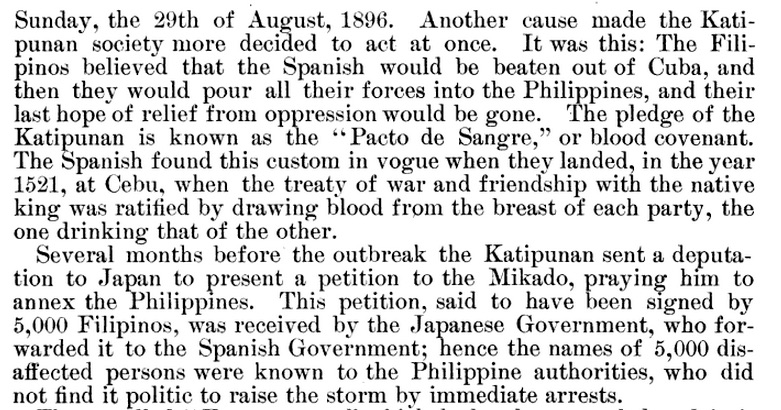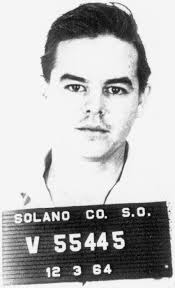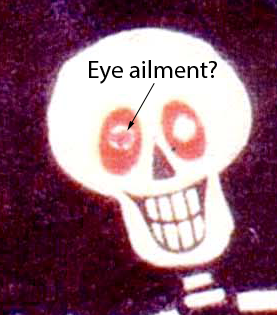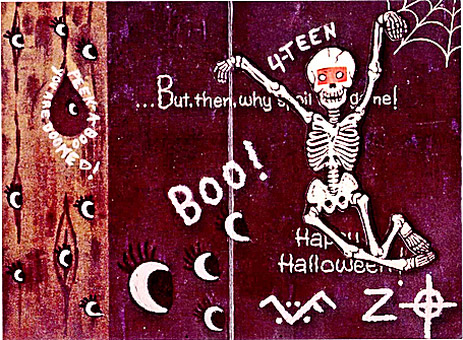I randomly stumbled upon the Katipunan while looking into something else about the case. Has anyone researched this Filipino revolutionary organization that practiced Masonic-type rituals in connection with Z? Check out these outfits:
And the symbols associated with the different levels:
Katipon. First degree members. Other symbols: Black hood, revolver and/or bolo.
Kawal. Second degree members. Other symbols: green ribboned-medallion with Malayan K inscription.
Bayani. Third degree members. Other symbols: Red hood and sash, with green borders.
A cuter version:
The bolo:
The Katipon outfit and symbols definitely evoke Lake Berryessa, and the Bayani outfit reminds me of the red mask on the Halloween card. Could it be that Z was fantasizing about ascending through these levels? If so, is there a Phillippines connection to the case? Curiously, the abbreviated name for the organization is KKK.
More here in this wikipedia article: https://en.wikipedia.org/wiki/Katipunan
Just thought it was weird…
There could be something to this. Apparently, there was a large Filipino community working at Mare Island. If Z was living in the area, he could have easily been exposed to the Katipunan ideas:
Word War II brought Vallejo its biggest economic boom. The Mare Island Naval Ship
Yard had shifts working around the clock. The Navy Yard work force increased from
a pre-war 6,512 to 43,704 workers according to a letter from the Mare Island Hospital
commander to the Navy Surgeon General, dated June 1, 1942. Mare Island developed
its own transit system so that workers could be bused in from as far away as San Jose
and Santa Rosa. African Americans from the south flocked to Vallejo and Vallejo
became the home for the largest Filipino population outside of the Philippines. While
Rosie the Riveter was working hard contributing gender diversity to the historically all
male shipyard, Vallejo was turning into the most ethnically diverse city in the USA.
Here’s a blurb from wikipedia:
One of the earliest records of a Filipino settling in the San Francisco Bay Area occurred in the mid-19th Century, when a Filipino immigrant and his Miwok wife settled in Lairds Landing on Marin County coast;many Coast Miwok can trace their lineage to this couple. Significant migration began in the early 20th Century, including upper-class mestizo businessmen, mariners, and students (known as pensionados). Another group of Filipinos who immigrated to the Bay Area was war brides, many of whom married Africa-American "buffalo soldiers". Additionally, other immigrants came through the U.S. Military, some through the Presidio of San Francisco, and others as migrant workers on their way to the points inland; many of these Filipinos would permanently settle down in the Bay Area, establishing "Manilatown" on Kearny Street (next to Chinatown). At its largest size, "Manilatown" was home to at least ten-thousand Filipinos, the last of whom were evicted in August 1977 from the International Hotel. After 1965, Filipinos from the Philippines began to immigrate to San Francisco, concentrating in the South of Market. In 1970, the San Francisco-Oakland metropolitan area had the largest population of Filipinos of any metropolitan area in the continental United States at the time (44,326). Two other nearby metropolitan areas also had a population of Filipinos greater than five thousand in 1970, San Jose (6,768), and Salinas-Monterey (6,147). Due to a change in the ethnic make up of the Yerba Buena neighborhood, and with the construction of the Dimasalang House in 1979, four streets names were changed to honor notable Filipinos. By 1990, thirty percent of the population in South of Market was Filipino American.
The 2000 Census showed that the greater San Francisco Bay Area was home to approximately 320,000 residents of Filipino descent, with the largest concentration living in Santa Clara County. In the mid-2000s Filipino Americans were between 1/5th and 1/4th of the total population of Vallejo, having been drawn there by agriculture and Mare Island Naval Shipyard. In 2007, there were about a hundred thousand Filipino Americans living in the East Bay alone. By the time of the 2010 Census the greater San Francisco Bay Area was home to 463,458 Filipino Americans and Multiracial Filipino Americans; Santa Clara county continued to have the largest concentration in the area. In 2011, 9% of all Filipino immigrants to the United States reside in the San Francisco metropolitan area, and an additional 3% resided in the San Jose metropolitan area. Daly City, in the San Francisco Bay Area, has the highest concentration of Filipino Americans of any municipality in the United States; Filipino Americans comprise 35% of the city’s population.
And there’s also a Philippines connection to "slaves in the afterlife":
Worth exploring
There is more than one way to lose your life to a killer
http://www.zodiackillersite.com/
http://zodiackillersite.blogspot.com/
https://twitter.com/Morf13ZKS
Yup it’s interesting for sure to me ![]() the Mikado is based on a Japanese executioner which I believe IMHO inspired much of his Outfit, but I also think Zodiac was multi faceted and drew inspiration from many different sources to help create the persona he desired. IMO
the Mikado is based on a Japanese executioner which I believe IMHO inspired much of his Outfit, but I also think Zodiac was multi faceted and drew inspiration from many different sources to help create the persona he desired. IMO
I’ll be using this thread to post "connections" between the case and the Philippines, tenuous though they may be. No theory at present; just exploring. I agree with the glurk/Norse comments in the "irks" thread, so please don’t think I’m advocating that this stuff is dispositive of anything.
Katipunan and the Mikado:
Connection Type: Indirect; assumes Lake Berryessa costume based on Katipunan symbology
Question: In 1969, what type of person would be interested in a political movement from the turn of the century?
Some Possibilities: Historian (Asian History, Military History), Political Scientist, Native Filipino, Military personnel stationed in the Philippines, Missionary, Members of a similar revolutionary organization, Others?
The 2 George Waterses:
George Waters, a native Filipino, identified as a suspect in the BRS killing. He made threatening overtures to Darlene Ferrin:
Connection Type: Direct
http://www.zodiackiller.com/DFR14.html
http://www.zodiackiller.com/DFR23.html
http://www.zodiackiller.com/DFR24.html
http://www.zodiackiller.com/DFR28.html (not sure if this is a different George)
http://www.zodiackiller.com/DFR29.html
http://www.zodiackiller.com/DFR30.html
George Waters, a San Francisco physician who was the son of missionaries to the Philippines. He was a paranoid schizophrenic in thrall to a man named "George Brody". The two were suspected in the abduction of Waters’ daughter, Anna.
Connection Type: (Very) Indirect based on life circumstances; Shares name with above suspect but never identified in official reports.
Info on Anna’s abduction:
http://charleyproject.org/cases/w/waters_anna.html
http://annaseek.blogspot.com/
http://www.websleuths.com/forums/forumd … ian-Waters
Slaves For My Afterlife-Mindanao
The 408 cipher solution contained a reference to "slaves for my afterlife": http://www.zodiackiller.com/DFR35.html
The Stanford research center informed police that the concept possibly originated in Mindanao: http://www.zodiackiller.com/DFR36.html
Connection Type: Direct; from police reports; other origins for the concept have been suggested, in particular Viking culture
Mindanao is the second largest and southernmost island in the Philippines: https://en.wikipedia.org/wiki/Mindanao
The Manobos (Manuvus), an indigenous tribe of Mindanao had the following social structure:
The traditional social structure consists of four classes: the bagani, the baylan, commoner, and slave. The bagani class, now gone, defended the community and went to battle. The baylan, who can still be found, is a male or female priest and healer. The commoners were farmers; and the slaves, who had been seized in raids, belonged to the ruler and were usually given away as part of the bridewealth. Village members could also become enslaved if they could not pay the penalty for a crime they had committed, such as thievery, destruction of property, adultery, or verbal offense. Slaves, however could win their freedom through diligence in the fulfillment of their duties, faithfulness to their master, or payment of their debt through servitude. Slaves who were treated like members of the family although still in servitude are bilew, and it was considered an insult if they were referred to as slaves. One who did so was committing tempela, ridiculing someone for their low status physical handicap.
More here: http://litera1no4.tripod.com/manobo_frame.html
When a Manoban datu (Chieftain) died, a slave was usually buried with him to row his master’s boat into the new life. The datu’s people showed their sorrow by holding their spears head down during the period of mourning. Mourners refrained from eating meat but instead subsisted on camote and soft rice. More here: http://www.librarylink.org.ph/featartic … ticleid=74
Visayan Writing-Cheri Jo Bates Letter
The Visayan people live in the Visayan island group and in many parts of Mindanao: https://en.wikipedia.org/wiki/Visayans
The "MLZ" sign-off on the letter: viewtopic.php?f=79&t=153&p=31188&hilit=MLZ#p31188
is reminiscent of Visayan writing (IMHO):
Lake Berryessa-The Balangiga Massacre
On Sept. 27, 1969, the Zodiac attacked a young couple at Lake Berryessa with a knife.
On Sept. 27, 1901, in the town of Balangiga on the island of Samar, Filipino nationalists, all skilled bolomen, engaged their plot to wipe out the US 9th infantry. The attack is regarded by Filipinos as one of the bravest acts of the Spanish-American war. In retaliation, General Jacob H. Smith ordered the killing of every male Filipino over the age of ten. Over 2000 are estimated to have died.
Samar is in the Visayan group of islands, just north of Mindanao.
http://www.bibingka.com/phg/balangiga/
https://en.wikipedia.org/wiki/Balangiga_massacre
Re: Slaves in the afterlife.
Burying slaves (or servants, concubines, what have you) along with a prominent person is a fairly common concept in many cultures (historically speaking, that is). It’s too generic to be of much use to us, IMO.
What we want is something more specific: The belief that you can – as Z claims, whether he’s serious or not – make someone your slave in the afterlife by killing them in this one.
AFAIK similar concepts can be found in certain cultures, i.e. the belief that you can (in some form and to some extent) "enslave" someone by defeating them in battle, for instance.
Anyway, this is interesting stuff, Barry – and presented in the right way.
Philippines Burial Traditions
The below speculation is admittedly wacky. Dismiss accordingly ![]()
The Ilongot are a tribe inhabiting the east side of Luzon: https://en.wikipedia.org/wiki/Ilongot_people
- The Ilongot are buried in a sitting position. If a woman died in childbirth or experienced a violent death her hands are tied to her feet to prevent her "ghost" from roaming. http://factsanddetails.com/southeast-as … -3882.html
Possible Connection: Bryan Hartnell and Cecelia Shepard were tied up before Zodiac brutally stabbed them: http://www.zodiackiller.com/LBReport24.html [/list:u:1isv12mi]
The B’laan are one of the indigenous tribes of Mindanao: https://en.wikipedia.org/wiki/B%27laan_people
- Traditionally, the B’laan have several ways of disposing of their dead. Burial in the ground, hanging the corpse up in tree branches, inserting the cadaver into the trunk of a tree, abandoning the body in the house where the person died (the house is also abandoned), or just abandoning the body where the person died. In each case, there is the element of respect and/or love for the departed. There is also a fear that evil first may have brought about the death of their relative.
Burial of the B’laan often simply involves wrapping the dead in a rolled that, binding this with lu-es or rattan and burying it. In instances where the bereaved have no one to assist them, the dead is merely lift in the house where they died and the house and body are abandoned. It was explained that leaving the body alone in the house is an expression of love. Death is usually associated with tasu or bad luck/bad spirits. This is often why the relatives of the declared abandon the house.
Some corpse, however, are merely tied several feet up a tree. This usually occurs when someone has been killed in a running battle in the forest. As a result, there was little time to look after the dead. In some instances, when time is very short (perhaps during an armed conflict) the body is just lift where it fell. In case where a coffin is prepared, the trunk of a sizable klato tree, which is preferred because of its softness, it cut and the inside is carved out. The body is then inserted into the carved out section of the tree trunk. http://caresma.blogspot.com/2011/03/sac … ports.html
Far-fetched possible connection: "Peek Through the Pines" card: viewtopic.php?f=70&t=10 and "Guardian of the Pines" Christmas card: viewtopic.php?f=35&t=862&p=6955&hilit=guardian+of+the+pines#p6955; Is this how Donna Lass was "buried"?[/list:u:1isv12mi]
Dalikamata-The Halloween Card
One more eye-rolling "connection" ![]()
Dalikmata was the Visayan goddess of the eyes and eye ailments.
- Dalikamata has thousands of eyes all over her body, and is actually feared by the early people of Panay because it is said each eye represents a person and she can see all the good and bad they do in their lifetime. She hates people who are discourteous/disrespectful and curses them with blindness and cures the worthy of eye ailments.
Dalikamata, for her to be called the many-eyed diwata, is referred to in the Visayan myths as the "One who cannot be surprised" for she can see the past, present and future, and also the hearts and souls of men and the realm of the spirits and the invisible.
Dalikamata is a naturally silent character in myths, she doesn’t say that much except she loved humans and she was entrusted by Kan-Laon to look after his creatures to prevent them from straying. Dalikmata is the most reserved of the diwatas, an introvert and is also quite sensitive. Each night, some of her eyes cry for evil people who have committed foul acts,and in the morning her "tears" are found on vegetation as the "morning dew" which babaylans collect in bottles for their spells, especially in gaining the ability of the 3rd sight (third eye) or to gain the ability of clairvoyance.
http://vizayanmyths.blogspot.com/2013/0 … amata.html
https://en.wikipedia.org/wiki/Deities_o … _mythology
(Im)possible connections: The many eyes on the Halloween card representing 13 victims viewtopic.php?f=63&t=55; The red heart/blotch in the left eye on the front of the card representing an eye ailment? viewtopic.php?f=24&t=2179&p=28083&hilit=lazy+eye#p28083; Did Zodiac find fornication sinful? (re: lovers’ lanes); referencing the previous "Burial traditions" post, could that be represented by the "bird" (girl) in the tree?[/list:u:zcxvaqpo]
Re: Slaves in the afterlife.
Burying slaves (or servants, concubines, what have you) along with a prominent person is a fairly common concept in many cultures (historically speaking, that is). It’s too generic to be of much use to us, IMO.
What we want is something more specific: The belief that you can – as Z claims, whether he’s serious or not – make someone your slave in the afterlife by killing them in this one.
AFAIK similar concepts can be found in certain cultures, i.e. the belief that you can (in some form and to some extent) "enslave" someone by defeating them in battle, for instance.
Agreed. The Egyptians did it first, right? I do wonder why the Stanford researcher zeroed in on Mindanao when there are so many other cultures with similar beliefs. Anyone know? And on that note, has anyone investigated the person who gave the police the factoid? Hmmm…
Escape to Mindanao
Trying to summon the courage to watch what is probably a spectacularly bad TV movie on the theory that Z may have been inspired by TV programs as well as film (cf. "The Mikado" with Groucho Marx/aired 1960: viewtopic.php?f=62&t=216&p=35306&hilit=mikado#p35306 and "Batman" Episode #037, "The Zodiac Crimes"/aired 1967: http://www.imdb.com/title/tt0519558/ ). Anyone seen it who can spare me the pain?
Synopsis:
ESCAPE TO MINDANAO (Aired on TV 12/7/68) A powerful prisoner of war drama in which several American GI’s break away from a Japanese internment camp with a decoding device that is vital to their captors. Along the way they run into various assholes who slow up the works, including a sea captain, his voluptuous daughter and a black marketeer.
http://www.imdb.com/title/tt0062939/?ref_=fn_al_tt_1
https://www.youtube.com/watch?v=c59T7aMI1nc
According to the 1970 US census 3.3 percent of the population of Vallejo was Filipino. Make of that what you will.












